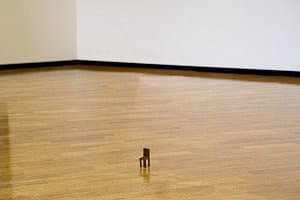

Joel Shapiro
Learn moreUntitled (chair) 1974
© Joel Shapiro. ARS/Copyright Agency Purchased 1974
More detail | PermalinkJoel Shapiro’s Untitled (chair) 1974 and Robert Wilson’s Freud hanging chair 1977 both exhibit the familiar features of a chair. Yet they, along with Wilson’s Nijinsky hanging table 1977[i], critique their respective forms through the implausibility of functioning as items of furniture. These works, moreover, create a theatrical presence in the gallery. Shapiro’s minute object (only 7.9 cm tall) and Wilson’s hanging sculptures commandeer the spaces they inhabit while challenging viewers’ expectations and responses.
Shapiro’s work is critical of, and dependent on, the relationship between the spectator, the work of art and the context of display space. The placement of Untitled (chair) directly onto the gallery floor is crucial for the desired effect, without the usual barriers, plinths or ropes that separate the audience and work in a gallery. At first the object is easily overlooked or swamped by the surrounding expanse of floor, at odds with the usual points of reference—the height of the human figure and the size of an ordinary chair. A perceptual paradox is established whereby the diminutive size of the work enforces a physical distance, yet for the spectator there is an inherent familiarity with the object that allows it to defiantly occupy the shared space. As Shapiro explained:
Our bodies and our experience become condensed. The chair evokes physical memory … there was no need to make it any bigger. The scale of a piece is its viability in that size, not the size itself. Viability has to do with the fact that it functions as a sculpture.[ii]
[i] Wilson’s Freud hanging chair 1977 and ‘companion’ Nijinsky hanging table 1977 were both issued in edition by Multiples Inc and exhibited in Further furniture at Marian Goodman Gallery, New York in 1980.
[ii] Joel Shapiro, interviewed by Richard Marshall, May 1982, in ‘Commentaries’, Joel Shapiro, Whitney Museum of American Art, New York, 1982, p 96.

